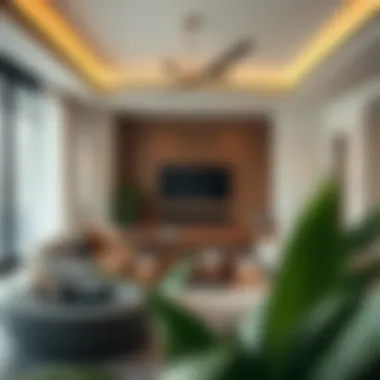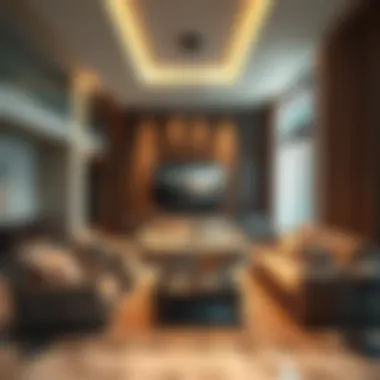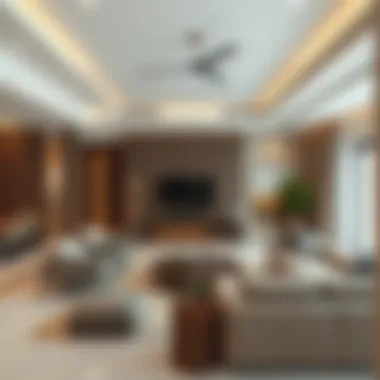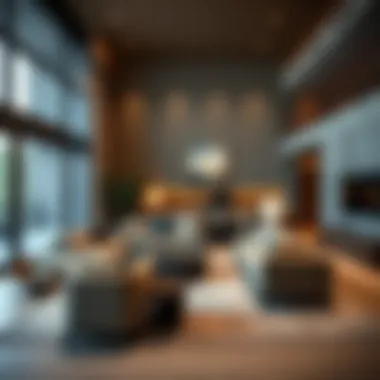Designing Family Spaces in Karama: A Cultural Insight


Intro
Family living spaces are not just functional areas; they serve as the heart of the home, especially in a vibrant community like Karama, Dubai. In a region known for its rich cultural tapestry, the design and function of the family room reflect both traditional values and modern aspirations. These spaces are where families gather, communicate, and share experiences, making them pivotal to familial bonds.
The family room in Karama is more than a place to watch television or entertain guests. It embodies the essence of togetherness, blending the comfort of home with cultural significance. With the ongoing transformations in Dubai's real estate market, understanding how to design these spaces effectively is crucial for both homeowners and potential investors. As urban living becomes more popular, the focus on optimizing family rooms becomes increasingly salient, highlighting the delicate balance between personal needs and collective values.
This article will explore the nuances of these living spaces, offering insights into architectural styles, interior design elements, and tips for creating an inviting atmosphere. You’ll learn about how modern trends are shaping these experiences while still paying homage to tradition. Understanding the dynamics of family interactions within these spaces will equip you with the knowledge necessary to appreciate and make informed decisions regarding family-centric living in Karama.
Understanding the Karama Neighborhood
The neighborhood of Karama presents a unique microcosm of life in Dubai, making it essential to comprehend the complexities that shape family living spaces. For homebuyers, investors, and agents alike, a deeper understanding of this area can significantly influence decisions and strategies in the local real estate market. Karama, with its rich tapestry woven from diverse cultures, stands as a testament to community spirit and family-centric designs that resonate within its family rooms.
Historical Overview of Karama
Karama’s history, tracing back several decades, reveals a neighborhood that has evolved from humble beginnings into a vibrant community hub. Established in the mid-20th century, the area primarily served as a residential locale for expatriates and local families.
The name "Karama," which translates to "dignity" in Arabic, reflects the community-oriented philosophy embedded in its design and layout. It’s fascinating to note how this initial vision has persisted, steering the development of the family room concept within the homes here.
Through the years, Karama has seen waves of transformation driven by both socio-economic shifts and the influx of various cultures. With the rise of multi-family living, architectural designs have begun to manifest the diverse needs of its residents. Families now prioritize spacious, multifunctional family rooms, echoing the trend of creating welcoming spaces that facilitate social interactions and bonding.
Cultural Significance of Karama
The cultural fabric of Karama is integral to understanding its family spaces. The neighborhood stands out due to its rich blend of traditions, languages, and lifestyles, which can be seen reflected in the diverse designs of family rooms.
From informal gatherings to cultural celebrations, Karama's family rooms often serve as the heart of the home, fostering a sense of belonging and warmth. The design practices here incorporate elements from various cultures, leading to settings that are both functional and inviting. This cultural melange offers homeowners a variety of stylistic choices, ensuring that family rooms not only serve their practical purpose but also embody the home's narrative.
Demographics and Community Dynamics
A look at Karama's demographics demonstrates a community rich in variety. With a mix of expatriates and Emiratis, the area houses families of different sizes, backgrounds, and lifestyles. This diversity contributes to an organic community dynamic where traditions intertwine and evolve, providing an enriching environment for children and adults alike.
Interestingly, the sense of community thrives in Karama. Neighbors often engage in shared traditions and experiences, fostering strong connections. Family rooms in this context become vital, as they serve as gathering spots for relatives and friends. Here are some observations about family dynamics:
- Intergenerational Living: Many homes accommodate grandparents and extended families, requiring spacious and adaptable family rooms to cater to various activities.
- Cultural Events: Family gatherings, especially during festivals or celebrations, underscore the significance of these communal spaces.
- Community Engagement: Spaces are designed for not just the family unit but also for hosting neighbors, reflecting the importance of community ties.
The Concept of the Family Room
The family room serves as the heart of a home, especially in a vibrant community like Karama. Here, not only is it a space for relaxation, but it also embodies the cultural tapestry and social interactions prevalent throughout the neighborhood. When pondering the design and utility of family rooms, it's crucial to understand not just the physical space but also the deeper connections cultivated within these walls.
In essence, a family room in Karama is more than a mere gathering place. It's where families bond, traditions are celebrated, and community interactions occur. The layout and design can influence family dynamics and significantly affect the flow of daily life. Therefore, thoughtful consideration should be given to crafting this space to cater to the needs and preferences of its users.
Defining Family Spaces in Karama
In the context of Karama, family spaces often reflect local traditions and the diverse population residing there. Homes tend to incorporate a blend of functionality and aesthetics. In many cases, these rooms are designed to be adaptable, serving multiple purposes ranging from a casual hangout space to a venue for family gatherings or even entertaining guests.
For instance, consider the typical design elements in a Karama family room. Open plans are common; they facilitate a sense of togetherness. Often, you will find plush seating arrangements emphasizing comfort and warmth. Accent cushions, traditional artwork, and drapes may echo the rich cultural backdrop of the neighborhood.
Moreover, spatial arrangement takes precedence in how these rooms are utilized. Movement paths that help people interact naturally and intuitively resonate well in family rooms. Elements like coffee tables often double as game or activity hubs, further enriching the experience.


Historical Context of Family Rooms
Family rooms have evolved considerably over the years, shaped by societal norms, architectural advancements, and cultural shifts. Initially, the family room was often a secondary space, less significant than formal living rooms. However, as lifestyles transformed and societies became more casual, these spaces gained prominence.
In Karama, the influence of both modern and traditional aspects can be observed. Older homes may still echo the styles of the past, featuring intricate wooden elements or traditional Arabic motifs in their design. Newer constructions, on the other hand, reflect a fusion of contemporary designs while maintaining cultural relevance.
"A family’s unity is often reflected in their shared spaces. The family room becomes an area where history meets the future, accommodating growing family dynamics while respecting past traditions."
Through the decades, as families started to prioritize togetherness and shared experiences, the family room evolved from a secluded space to become more of a communal hub. The configuration—be it sleek lines of modern furniture or the warmth of a classic layout—speaks to the values and journeys of those who call Karama home. By understanding this context, prospective homeowners can better appreciate what their family room might reflect about their own heritage and future.
Architectural Styles of Family Rooms in Karama
When considering family living spaces, the architectural styles used in family rooms play a critical role in not just aesthetics, but also in functionality and cultural representation. The architecture in Karama reflects a blend of traditional and contemporary influences that cater to the practical needs of families while honoring the rich cultural history of the neighborhood.
An essential aspect of understanding family rooms in this area is how architecture shapes community interactions. The way spaces are designed affects how families gather, celebrate special occasions, and introduce guests to their homes. This narrative leads to a better comprehension of the evolving landscape of family living in Karama.
Traditional Designs and Their Influence
Karama boasts a variety of traditional designs prevalent in its family rooms. These designs often draw inspiration from classic Arabic architecture, emphasizing large spaces complemented by intricate details.
Key Elements of Traditional Designs:
- High Ceilings: Traditionally, high ceilings allow for better airflow, crucial in a hot climate like Dubai’s.
- Majlis Spaces: These are large sitting areas often found in family rooms, designed for hospitality and conversation. They reflect the significance of social ties and family networks.
- Wood and Stone Features: Natural materials are frequently utilized for flooring and decorative elements, connecting the family rooms to local cultural heritage.
The influence of these designs is palpable in how families use their spaces. While fostering warmth and intimacy, they also encourage openness and communication. The layout is designed to accommodate gatherings, often structured around the central majlis, where families catch up over coffee and snacks.
Contemporary Trends in Family Room Architecture
In recent years, Karama has witnessed a shift towards contemporary styles in family room designs, blending modern aesthetics with traditional elements. These designs cater to younger generations seeking functionality without sacrificing cultural integrity.
Noteworthy Trends:
- Open Concept Layouts: Many modern family rooms lean towards open layouts, merging living spaces. This design fosters a sense of togetherness while allowing for versatility in room usage.
- Sustainable Practices: Growing awareness of environmental issues has led designers to incorporate energy-efficient materials and natural lighting solutions, such as large windows.
- Minimalistic Furniture: To maintain an uncluttered environment, families now opt for smart furniture choices that serve multiple functions, which is particularly advantageous in smaller homes.
Contemporary designs in Karama demonstrate how architecture can adapt to the changing lifestyles of families, emphasizing ease of maintenance and functionality. These modern spaces cater to the needs of the community while allowing for personal expression, ultimately bridging the gap between tradition and modernity.
The architectural evolution of family rooms in Karama not only enhances aesthetic appeal but also nurtures social connections within the community.
Understanding and recognizing these architectural styles provides valuable insight for homebuyers and investors, allowing them to appreciate the nuances of family living in Karama. By considering both the traditional and contemporary influences, potential homeowners can make informed decisions that align with their needs and aspirations.
Interior Design Considerations
When it comes to family living spaces, especially within the vibrant culture of Karama, interior design takes on a role far beyond mere aesthetics. It shapes the functionality of daily life and transforms households into homes. In this context, crucial design considerations not only enhance the visual appeal but also provide practical benefits and meaningful connections for families.
Good design fosters interactions, encourages comfort, and meets the diverse needs of family members. Thus, understanding how different elements work together can create harmonious environments that reflect both the individuality of a family and the cultural essence of Karama.
Color Schemes and Aesthetics
Color is a powerful tool in interior design, influencing mood and perception. In Karama, colors often resonate with local influences and personal preferences. Warmer shades like terracotta or earthy browns may invoke the surrounding environment, while vibrant hues like turquoise or saffron can reflect the sociable spirit of the community.


- Warm Colors: Create an inviting atmosphere, making family rooms feel cozy and welcoming.
- Cool Colors: Bring calm and relaxation—a perfect balance for busy family dynamics.
Utilizing a mixed color palette is a common choice. Many opt for neutral tones as a base, then punctuate these with colorful accents through decor and furnishings. Natural light plays a significant role as well. Large windows that allow sunlight effectively enhance these colors, making spaces feel alive and more integrated with the outdoors. Such considerations ensure that the family room embodies warmth, functionality, and beauty all at once.
Furniture Selection and Arrangement
The selection and arrangement of furniture in family rooms cannot be overlooked. A common pitfall is overcrowding spaces with large furniture pieces that stifle movement and interaction. Instead, family rooms in Karama often feature versatile furnishings that adapt to various activities—from casual lounging to hosting family gatherings.
- Choosing the Right Pieces: It's vital to select comfortable, durable furniture that suits different ages and preferences within the family. Sofas with washable fabrics or chairs that provide excellent back support are popular choices.
- Arrangement Strategies: A U- or L-shaped seating arrangement effectively promotes conversation while maximizing space. Multi-functional furniture, such as ottomans that double as storage, can also increase efficiency.
Thoughtful arrangements can elevate the functionality of a family room, allowing for ease of movement and fostering deeper connections between family members.
Incorporating Cultural Elements
Cultural identity plays a significant role in shaping the family room's ambiance. In a multicultural community like Karama, infusing local and familial heritage into the design can create a sense of belonging and pride. Incorporating art, textiles, and decor that reflect one’s heritage can evoke memories and stories that resonate within the family.
- Art and Decorations: Local artists may offer unique pieces that celebrate Emirati culture; decorative items from around the world can also create vibrant dialogues between different traditions.
- Textiles: Using traditional fabrics in cushions and throws not only provides comfort but also layers texture and color into the space, reinforcing cultural ties.
Adopting these cultural elements not only enhances the aesthetic but also honors the diverse backgrounds that coexist in Karama, inviting family members to engage with and appreciate their lineage in a contemporary setting.
"A well-designed family room is like a warm hug—embracing everyone with a sense of belonging and comfort."
Ultimately, focusing on these interior design considerations will significantly enhance the family living experience. Balancing aesthetics, function, and cultural roots makes for a truly unique family room in Karama, accommodating the myriad of memories and experiences that will unfold within its walls.
Functionality and Use of Family Rooms
Family rooms are often the heart of a household, particularly in the bustling community of Karama. These spaces not only serve as a sanctuary for relaxation but also play a pivotal role in family interactions and community bonding. Understanding their functionality involves considering how these rooms adapt to varying needs throughout the day, how they mirror the values of the community, and how they can be optimized for both comfort and utility.
Creating a Multi-Purpose Space
In Karama, family rooms are expected to be versatile, accommodating a wide range of activities from casual movie nights to more formal gatherings. One key element in this regard is furniture arrangement. Zoning areas can create distinct spaces for different uses within the same room. For example, a large sectional sofa might anchor a cozy seating area for family movie time, while adjacent bean bags and a low table facilitate game nights or casual chats.
Moreover, practical storage solutions are essential in these spaces. Built-in shelves or multifunctional furniture, like an ottoman that doubles as storage, can help keep family rooms tidy while offering easy access to games, books, or electronics without cluttering the space.
The Role of Family Rooms in Social Interactions
Family rooms in Karama serve as more than just gathering places; they function as vital social hubs where relationships are nurtured. The layout of a family room can significantly enhance social interactions. Open floor plans encourage conversation flow, while welcoming designs make guests feel comfortable and at ease.
Family rooms are often the scene for celebratory events, such as birthdays, or holiday gatherings. Thus, the design should reflect the cultural influences specific to Karama. Consider adding cultural artwork or traditional elements that resonate with the family's heritage. This not only enriches the ambiance but also fosters a sense of belonging and community.
"The family room is where lasting memories are created, from story-telling to quiet evenings; it encapsulates what it means to be a family."
Market Trends Impacting Family Room Designs
In exploring the landscape of family living spaces, particularly within the vibrant context of Karama, it’s essential to understand the market trends that shape family room designs. Over the past few years, a noticeable shift in homebuyer preferences has emerged, driven by cultural, technological, and economic factors. This section dissects these varied influences, providing insights that can help potential buyers and investors navigate the evolving dynamics in family room designs.
Emerging Preferences Among Homebuyers


Homebuyers today often seek family rooms that offer both functionality and aesthetic charm. Among the trends shaping these preferences are:
- Flexibility and Multipurpose Use: Many families now value spaces that can be easily adapted for different activities. The traditional notion of a family room has morphed into a multi-functional area, where movie nights blend seamlessly with home offices or play areas. Homebuyers are looking for layouts that allow for these transitions without losing a sense of coziness.
- Sustainability: More buyers are prioritizing eco-friendly options when it comes to materials and energy-efficient appliances. The demand for sustainable furniture, which incorporates reclaimed woods or recycled materials, is gaining traction. This shift reflects a broader awareness of environmental issues and a desire to reduce one’s carbon footprint.
- Cultural Influence: In a culturally diverse area like Karama, there is an increasing inclination for designs that reflect one's heritage. Buyers often seek to include traditional elements, such as specific textiles or architectural motifs, that resonate with their background, creating family rooms that are not only functional but also rich in personal storytelling.
Impact of Technology on Family Room Spaces
Technology is significantly reshaping the way family rooms are designed and utilized. Modern innovations offer both comfort and connectivity in daily family life. Key influences include:
- Smart Home Integration: The advent of smart technology has led many homeowners to look for family rooms equipped with smart features. From automated lighting to voice-activated entertainment systems, these innovations add convenience and enhance the overall living experience. Homebuyers are often drawn to properties with existing smart home systems to save on future upgrades.
- Streaming Services and Home Entertainment: The rise of streaming platforms has led families to seek larger screens and better sound systems in their family rooms. This situation has prompted an increase in open spaces, designed not only for passive viewing but also for interactive game nights or virtual gatherings.
- Increased Demand for Connectivity: With remote work and online learning on the rise, homebuyers are looking for family rooms that offer solid Wi-Fi connections and desk areas equipped for productivity. Having a designated spot for work or study embedded within the family space is becoming increasingly important.
"The family room is evolving from a place of isolation to a hub of activity, blending entertainment with practicality."
To summarize, understanding the current market trends impacting family room designs can offer invaluable insights for potential homebuyers and investors looking to navigate the real estate landscape in Karama. By embracing flexibility, sustainability, and technological integration, one can make informed decisions that reflect both personal style and practical needs.
Legal and Financial Considerations for Homebuyers
When embarking on the journey to purchase a family home in Karama, it’s crucial to understand the underpinning legal and financial landscapes that govern real estate transactions in Dubai. This information not only aids in ensuring compliance with local regulations but also aids buyers in making informed decisions that resonate with their financial aspirations.
Understanding Property Regulations in Dubai
Navigating the property laws in Dubai can seem like untangling a web of complex statutes and requirements, but knowing these regulations helps to avoid potential pitfalls. For example, foreign investors may need to familiarize themselves with the laws surrounding freehold properties in specific zones, including Karama, where ownership laws differ markedly from other emirates.
Some key considerations include:
- Freehold vs. Leasehold: Understanding whether the property is freehold can significantly influence investment decisions. In freehold areas, buyers own the dwelling and land; with leasehold, ownership is temporary.
- Regulatory Bodies: The Dubai Land Department plays a pivotal role in processing real estate transactions. Knowledge of this body’s procedures can streamline the buying process.
- Documentation: Essential paperwork such as the title deed, sale agreement, and NOC (No Objection Certificate) from the developer are vital in safeguarding your interests.
Given the vibrant property market in Karama, aligning with local real estate agents who are well-versed in these regulations can also help buyers avoid nasty surprises down the line.
Financing Family Homes in Karama
Securing financing for a family home in Karama often involves engaging with both local banks and international financial institutions. It’s wise to delve into various mortgage products and interest rates, ensuring a tailored fit for individual needs. Buyers should consider the following aspects when assessing financing options:
- Mortgage Types: Be aware of fixed-rate mortgages versus variable-rate options, as each carries unique implications for long-term financial commitments. Some banks may even offer sharia-compliant financing options that align with Islamic finance principles.
- Required Documentation: Standard requirements typically include proof of income, credit history, and residency details. Understanding these beforehand can facilitate a smoother approval process.
- Eligibility Criteria: Many banks set minimum income thresholds for prospective borrowers and may also look at your existing debt commitments. Clarity on these requirements can prevent delays.
Additionally, budgeting beyond the purchase price is essential. This includes factoring in property registration fees, maintenance costs, and potential renovations that might be necessary to achieve desired family living standards.
"Understanding the legal and financial implications when buying a home is just as important as selecting the right living space."
End
In the exploration of family living spaces, particularly the family room in Karama, one must recognize the critical role these rooms play not only in the architectural landscape but also in the emotional fabric of everyday life. As depicted throughout this article, family rooms are essential hubs where interaction flourishes and memories are forged. They can bridge generations, providing a central point for activities that range from casual gatherings to significant family celebrations.
Summary of Key Insights
The discussions presented have underscored several key insights:
- Cultural Relevance: Family rooms in Karama often reflect local traditions, integrating unique cultural elements into their design, which enhances their significance.
- Architectural Diversity: The architectural styles observed range from traditional designs that honor cultural heritage to more modern interpretations that address contemporary living needs.
- Design Principles: Effective interior design can significantly influence functionality and warmth in these spaces. From color schemes that inspire calm to furniture arrangements that promote socialization, every detail matters.
- Market Dynamics: Current trends in the real estate market are leaning towards multifunctional spaces that cater to the evolving preferences of homeowners and investors alike.
By synthesizing these insights, potential homebuyers can better appreciate how thoughtful designs in family rooms can positively impact daily life and community ties.
Future Outlook for Family Living in Karama
Looking ahead, the family living experience in Karama is poised to evolve further, influenced by changing societal norms and technological innovations. Key projections include:
- Increased Emphasis on Comfort: The modern homebuyer will increasingly prioritize comfort over mere aesthetics in family room designs. This shift may lead to the incorporation of adaptable furniture solutions that cater to a variety of functions, thus optimizing space usage.
- Tech Integration: The presence of smart home technology is likely to become a staple in family rooms, enhancing both convenience and security. Features like automated lighting and integrated entertainment systems are becoming more common.
- Sustainability: Eco-friendly materials and energy-efficient designs are expected to take center stage as families become more environmentally conscious. This will also appeal to the younger demographic, who are keen on sustainability and responsible living.
- Social Connectivity: As social interactions continue to hold significant value, family rooms will evolve to accommodate a more blended lifestyle where home life and social activities intertwine.



